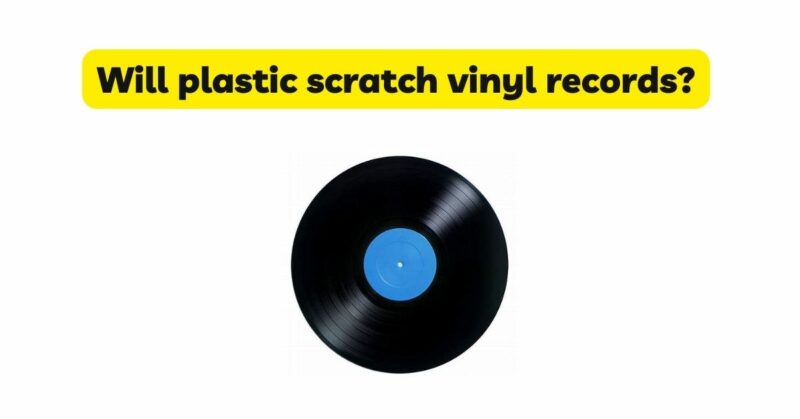Vinyl records hold a special place in the hearts of music enthusiasts, and proper care is paramount in preserving their sound quality and longevity. Among the concerns surrounding vinyl records, the question of whether plastic can scratch records often arises. In this article, we will delve into the relationship between plastic and vinyl, exploring the potential risks, debunking common misconceptions, and providing insights into the role of plastic in record preservation. By understanding the nuances of this topic, collectors can make informed decisions to ensure the optimal care and protection of their vinyl records.
- Nature of Vinyl Records: Vinyl records are composed of polyvinyl chloride (PVC), a relatively durable material that resists scratches and physical damage. The surface of a vinyl record is designed to withstand repeated contact with a stylus without incurring significant damage.
- Plastic as a Protective Barrier: Plastic, when used properly, can act as a protective barrier for vinyl records. High-quality plastic sleeves, such as polyethylene or polypropylene, can shield records from dust, dirt, and physical abrasions. They provide a smooth surface for records to slide in and out of, reducing the risk of incidental scratches.
- Factors that Contribute to Record Scratching: While plastic itself is unlikely to cause scratches on vinyl records, several other factors can contribute to scratching:
a. Dust and Debris: Dust particles or debris present on the record surface, stylus, or cleaning cloth can cause scratches when they come in contact with the grooves during playback. Proper cleaning techniques and regular maintenance help minimize the presence of dust and debris.
b. Poor Handling: Improper handling, such as rough treatment or using excessive force when inserting or removing records from sleeves, can increase the risk of scratching. It is essential to handle records with care, supporting them from the edges and avoiding contact with the grooves.
c. Contaminated Surfaces: If the plastic sleeve or record surface is contaminated with abrasive particles, such as sand or dirt, scratches may occur when records are inserted or removed. Regular cleaning of plastic sleeves and inspection of record surfaces help mitigate this risk.
- Choosing the Right Plastic Sleeve: Selecting the right plastic sleeve is crucial for maintaining the integrity of vinyl records:
a. Sleeve Thickness: Opting for thicker plastic sleeves can provide an additional protective layer and reduce the likelihood of incidental scratches. Thicker sleeves offer improved resistance to external pressures and provide a cushioning effect.
b. Smooth Surface: Plastic sleeves with smooth surfaces minimize the risk of scratching during the insertion or removal of records. Avoid using sleeves with rough or textured interiors that could potentially cause friction against the vinyl surface.
c. Proper Fit: Sleeves that provide a proper fit for the record, allowing for easy insertion and removal without excessive friction, are preferable. Ill-fitting sleeves may increase the chances of accidental scratches.
- Cleaning and Maintenance: Regular cleaning and maintenance of both plastic sleeves and vinyl records are essential for reducing the risk of scratches:
a. Sleeve Cleaning: Regularly clean plastic sleeves to remove any dust, debris, or contaminants that could potentially scratch the record surface. Use a lint-free cloth or a specialized cleaning solution recommended for plastic materials.
b. Record Cleaning: Properly clean vinyl records using appropriate methods and solutions. Removing dust, dirt, and static electricity from the record surface before inserting it into a plastic sleeve can help minimize the risk of scratches.
- Anti-Static Measures: Static electricity can attract dust particles, potentially leading to scratches. Incorporating anti-static measures, such as using anti-static inner sleeves or employing anti-static brushes, can help reduce static buildup and minimize the risk of scratching during playback.
- Storing Records Vertically: Storing records vertically, whether in plastic sleeves or alternative storage methods, can help prevent accidental scratches that may occur when records are stacked horizontally. Vertical storage reduces the likelihood of records rubbing against each other or being subjected to unnecessary friction.
- Regular Inspection: Regularly inspect records for any signs of damage or scratches. Lightly run your fingers across the record surface to detect any imperfections. Promptly address any issues, and avoid playing records that show visible scratches to prevent further damage.
- Environmental Considerations: Environmental factors, such as temperature and humidity, can impact the condition of both vinyl records and plastic sleeves. Avoid exposing records to extreme temperature fluctuations or high humidity levels, as these conditions can compromise the integrity of the record and increase the risk of scratches.
- Alternative Storage Options: For collectors concerned about scratches or other potential risks associated with plastic sleeves, alternative storage options are available. Acid-free paper inner sleeves or specialized record storage systems can provide added protection and reduce the risk of incidental scratches.
Conclusion: Contrary to popular belief, properly chosen and maintained plastic sleeves do not pose a significant risk of scratching vinyl records. The primary culprits for record scratching are dust, debris, poor handling, and contaminated surfaces. By implementing proper cleaning techniques, handling records with care, and selecting high-quality plastic sleeves, collectors can ensure the longevity and pristine condition of their vinyl records. Regular inspection and adherence to suitable environmental conditions further contribute to record preservation. With proper care and attention, vinyl enthusiasts can continue to enjoy their collections without unnecessary concerns about plastic-related scratches.


